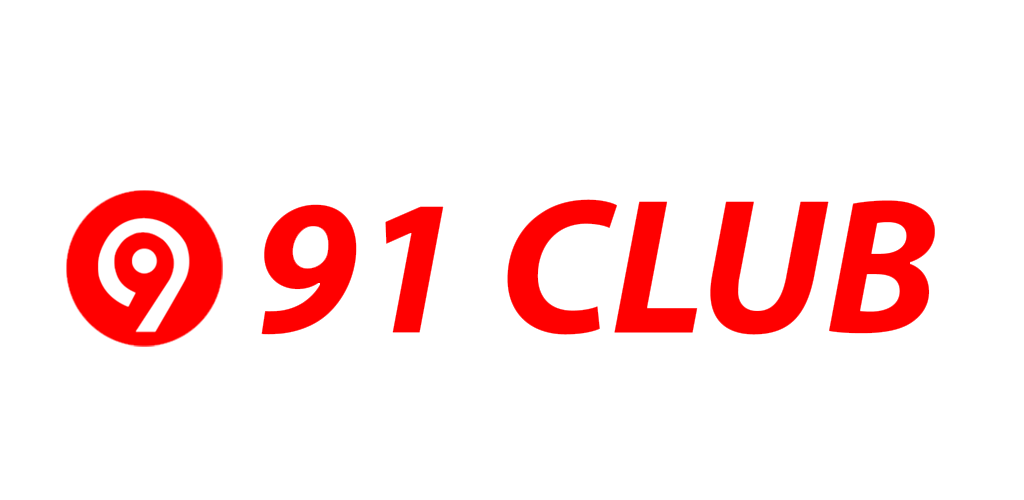You have 16 points, the dealer shows 10 – should you hit or stand? This is a situation that most Blackjack players face, and unfortunately, most choose based on gut feeling – and they’re usually wrong. Blackjack isn’t just about luck; it’s a game of probabilities and making the right decisions at the right time. The choice to hit, stand, double down, or split shouldn’t be based on intuition or superstition.
This comprehensive guide provides the optimal action chart for Blackjack – based on internationally recognized Basic Strategy. Whether you’re playing at 91 Club or any other platform, these guidelines will help you make confident, mathematically sound decisions that maximize your chances of winning.
Understanding the Four Core Actions in Blackjack
Before diving into when to use each action, it’s essential to understand what each option means and when it’s available to you.
1. Hit
Taking another card to improve your hand total. This is the most basic action available on every turn, but it comes with the risk of busting (going over 21). You can hit multiple times until you either stand, bust, or reach 21.
2. Stand
Keeping your current hand total without taking additional cards. This action signals that you’re satisfied with your hand and want to see how it compares to the dealer’s final total.
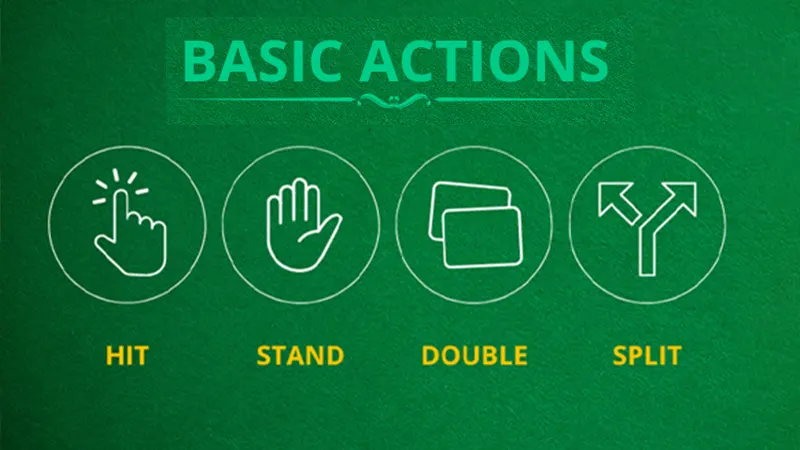
3. Double Down
Doubling your original bet in exchange for receiving exactly one more card. This action is only available on your first two cards (and sometimes after splitting). It’s a powerful move when used correctly, as it allows you to increase your bet when you have a statistical advantage.
4. Split
When you receive two cards of the same value, you can split them into two separate hands, each with its own bet equal to your original wager. Each hand is then played independently, and in most cases, you can double down or split again if the opportunity arises.
Important Note: These decisions shouldn’t be made randomly or based on “hunches.” Each situation has a mathematically optimal choice based on probability theory and thousands of computer simulations.
How to Determine the Right Time for Each Action
Making the correct decision in Blackjack depends on analyzing two critical factors that work together to determine your optimal strategy.
The Two-Factor Decision Framework
Every Blackjack decision should be based on:
- Your hand total (categorized as Hard, Soft, or Pair)
- The dealer’s upcard (the visible card that gives you insight into their potential hand)
Understanding Hand Types
Hard Hands
A hard hand either contains no Aces or counts any Aces as 1 point to avoid busting. These hands have no flexibility in their value.
- Examples: 9-7 = 16, K-5-2 = 17, A-6-9 = 16 (Ace counted as 1)
Soft Hands
A soft hand contains an Ace counted as 11 points, giving the hand flexibility since the Ace can be revalued to 1 if needed.
- Examples: A-6 = soft 17, A-2-4 = soft 17, A-A-5 = soft 17
Pairs
Two cards of identical value that can potentially be split into separate hands.
- Examples: 8-8, A-A, 10-K (any two 10-value cards)
General Strategic Principles
Basic Hitting and Standing Rules
- Under 12: Almost always hit (impossible to bust)
- 12-16: Decision depends heavily on dealer’s upcard
- 17 and above: Usually stand (high risk of busting if you hit)
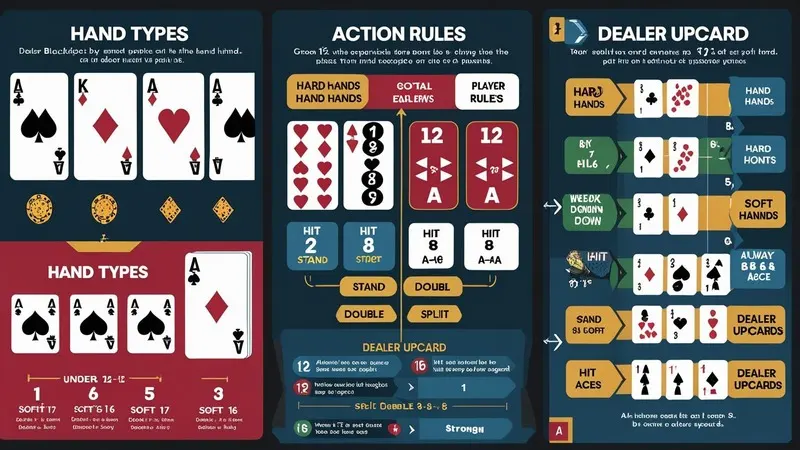
Double Down Opportunities
- 11 total: Excellent doubling opportunity, especially against weak dealer cards
- 10 total: Strong doubling candidate against most dealer upcards
- Soft hands: Often overlooked doubling opportunities (A-2 through A-7)
Splitting Guidelines
- Always split: 8-8 and A-A
- Never split: 10-10, 5-5, 4-4
- Situational splits: All other pairs depend on dealer’s upcard
The Dealer’s Upcard Impact
Understanding the dealer’s position is crucial for making optimal decisions:
Weak Dealer Cards (2-6)
When the dealer shows 2, 3, 4, 5, or 6, they have a higher probability of busting. This means:
- You can stand on lower totals (12-16)
- Double down more aggressively
- Split more pairs
Strong Dealer Cards (7, 8, 9, 10, A)
When the dealer shows a strong card, they’re likely to make a good hand. This requires:
- More aggressive hitting on marginal hands
- Fewer doubling opportunities
- More conservative splitting
The Complete Basic Strategy Chart
The Basic Strategy in Blackjack represents decades of mathematical analysis and computer simulation. Here’s how to read and apply these optimal decisions:
Hard Totals Strategy
Low Hard Totals (5-11)
- 5-8: Always hit (impossible to bust)
- 9: Double against dealer 3-6, otherwise hit
- 10: Double against dealer 2-9, hit against 10 or A
- 11: Double against dealer 2-10, hit against A
Marginal Hard Totals (12-16)
This is where most players make costly mistakes:
- 12: Stand against dealer 4-6, hit against 2-3 and 7-A
- 13-16: Stand against dealer 2-6, hit against 7-A
- Special case – 16 vs 10: This is statistically a hit, though it feels wrong
Strong Hard Totals (17-21)
- 17 and above: Always stand
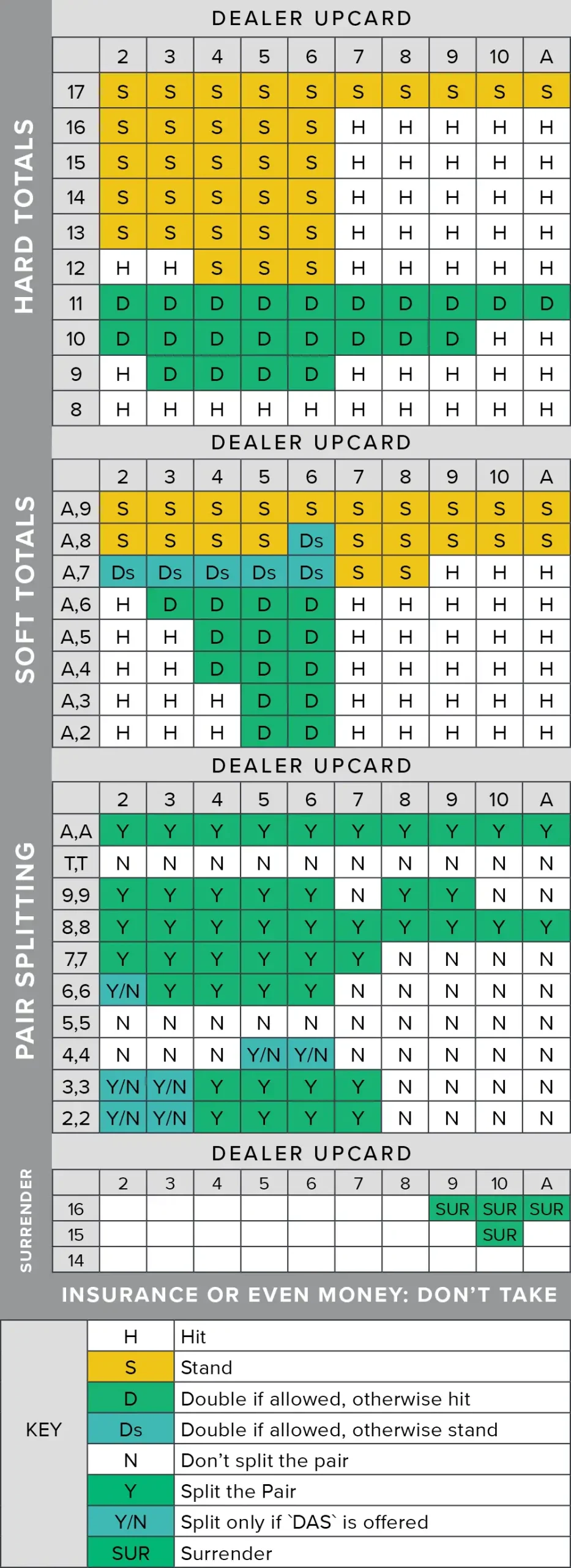
Soft Totals Strategy
Many players underestimate the power of soft hands:
- A-2, A-3: Double against dealer 5-6, otherwise hit
- A-4, A-5: Double against dealer 4-6, otherwise hit
- A-6: Double against dealer 3-6, otherwise hit
- A-7: Double against 3-6, stand against 2, 7, 8, hit against 9, 10, A
- A-8, A-9: Always stand
Pair Splitting Strategy
Always Split
- A-A: Creates two chances at Blackjack
- 8-8: Escape from the worst hand (16) to create two playable hands
Never Split
- 10-10: Already have 20, the second-best possible hand
- 5-5: Treat as 10 and follow doubling rules
Conditional Splits
- 2-2, 3-3: Split against dealer 2-7
- 6-6: Split against dealer 2-6
- 7-7: Split against dealer 2-7
- 9-9: Split against dealer 2-9 except 7, stand against 7, 10, A
Practice and Application at 91 Club
Online Blackjack platforms like 91 Club offer unique advantages for implementing proper strategy that aren’t available in live casino environments.
Advantages of Online Play
No Time Pressure
Unlike live casinos where you might feel rushed, online play allows you to:
- Consult your strategy chart without embarrassment
- Take time to analyze each decision
- Review hands after completion to identify mistakes
Practice Opportunities
Most online platforms offer:
- Free play modes to practice without risk
- Hand history reviews to track your decision-making
- Slower-paced games that allow for learning
Tips for Memorizing Basic Strategy
Learn in Sections
Don’t try to memorize the entire chart at once:
- Start with hard totals (most common situations)
- Add soft totals (often misplayed by beginners)
- Finish with pairs (less frequent but important)
Use Training Apps
Several mobile apps specialize in Basic Strategy training:
- Flash card style quizzes
- Timed decision challenges
- Progress tracking to identify weak areas
Practice with Simulation
Many online platforms offer practice modes where you can:
- Play thousands of hands quickly
- Get immediate feedback on incorrect decisions
- Build muscle memory for correct plays
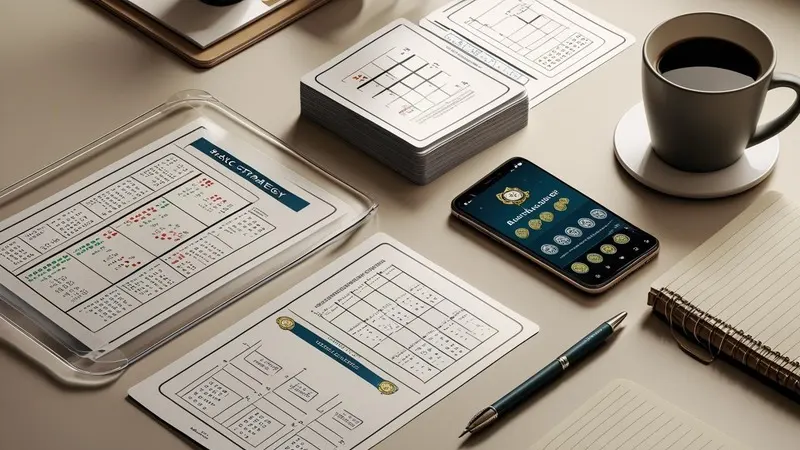
Combining Strategy with Bankroll Management
Perfect strategy means nothing without proper money management:
Bet Sizing Rules
- Never bet more than 5% of your bankroll on a single hand
- Reduce bet sizes during losing streaks
- Avoid the temptation to chase losses with larger bets
Session Management
- Set win and loss limits before you start playing
- Take breaks to avoid decision fatigue
- Don’t play when emotional or distracted
Image: online-blackjack-practice.jpg Caption: Screenshot of online Blackjack practice mode showing strategy hints
Making the Right Decision is Your Strongest Weapon
The difference between winning and losing Blackjack players isn’t luck – it’s the consistent application of mathematically sound decisions. Every time you choose to hit, stand, double down, or split based on proper strategy rather than intuition, you’re reducing the house edge and maximizing your long-term results.
The actions of hitting, standing, doubling down, and splitting should never be based on gut feelings or superstitions. Using the scientifically proven Basic Strategy chart helps minimize costly errors and significantly improves your chances of success.
- Save or print the Basic Strategy chart to reference while playing at 91 Club
- Practice regularly in free play mode until optimal decisions become automatic
- Start with small bets while you’re learning to minimize the cost of any remaining mistakes
In Blackjack, you won’t win every hand – that’s impossible. However, making the correct strategic decision in every situation will help you lose less when you’re behind and win more when you’re ahead. Over time, this mathematical edge compounds into significantly better results and a more enjoyable gaming experience.
Remember: Perfect play doesn’t guarantee wins, but it guarantees you’re giving yourself the best possible chance to succeed in every single hand you play.
